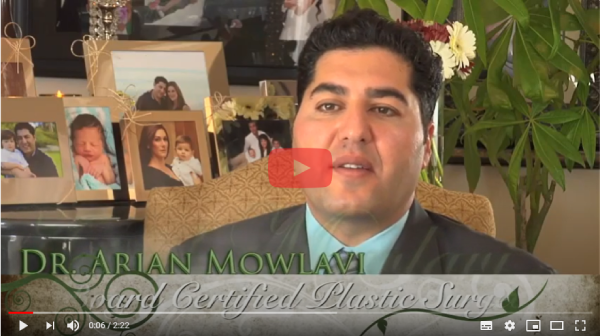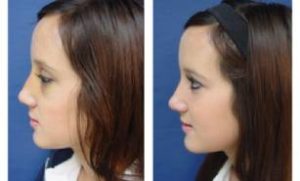Rhinoplasty Surgery by Dr. Laguna in Orange County, California

By virtue of being located in the middle of the face, the nose significantly affects your facial appeal. An appropriately shaped and sized nose will maintain facial balance and bring attention to your facial features including your eyes, cheeks, and lips.
The most common nasal concerns include:
- A prominent or wide nasal hump
- A poorly defined or large nasal tip
A prominent nasal hump can make your nose look like a parrot’s beak especially when viewed from the side as seen on lateral, i.e. profile, photographs. A generous nasal tip will be more distracting when viewed from the front and can detract others from appreciating your facial attributes.
When you consider rhinoplasty, it is critical to consider whether you want your hump reduced only or whether you want the tip and/or the entire nose redone.
For patients who just want the hump addressed, then a closed rhinoplasty will suffice. For those needing nasal tip refinement or desiring improvement of the entire nasal contour, then an open rhinoplasty procedure is recommended.
The difference between closed versus open rhinoplasty is significant with respect to operative techniques, operative times, and subsequently cost. Whereas the closed rhinoplasty can be performed in an hour, the open rhinoplasty requires two to three hours.
During your consultation with Dr. Mowlavi, you will have the opportunity to share your concerns, preview what your nose is going to look like using morphing technology, and to review which of the nasal surgeries, open versus close, will be the best option for you.
How Much Does Nose Surgery Cost?
The average cost of closed rhinoplasty is approximately $7,000 to $9,000 depending on whether you will also require functional improvements such as correction of a deviated septum or reduction of enlarged inferior turbinates.
The average cost of an open rhinoplasty surgery ranges between $10,000 to $15,000 depending on how much infrastructural support measures are required such as the need for rib grafting.
Book a Free Consultation for Rhinoplasty
A consultation with Dr. Mowlavi will help you appreciate what surgical maneuvers will be required to achieve your desired goal. It is recommended that you bring photos of your wish picks to your consultation.
Once you meet with the doctor, he will be able to give you the costs associated with this life-changing procedure.
23-year-old female student from Irvine 6 months following open rhinoplasty as well as submucous resection of a deviated septum and enlarged turbinates. The patient had a correction of severe nasal deformity with significant nasal dorsal deviation and nasal tip droop resulting in difficulty breathing. Upward rotation of the patient’s nasal tip has allowed for correction of her nasal tip droop which has improved not only her appearance but also breathing.
28-year-old female open Rhinoplasty to correct nasal dorsal hump and irregularity, as well as nasal tip highlight and position.
14-year-old female 1 month post-op following a closed rhinoplasty.
Rhinoplasty FAQs
Uni tip in rhinoplasty may occur in a novists’ hand and occurs when the two nasal tip domes are brought together too tightly; this will result in elimination of your tip defining points and the natural aesthetics of the tip.
It can take upto 3 months for the nasal dorsal swelling to resolve; if you are desiring more of a slope, it may be possible to promote more of a curvature by ensuring that scar tissue does not build up. This requires steroid injection and manual compression in the early postoperative period.
Two things you should know about rib graft rhinoplasty. First, for dorsal augmentation, we mince the cartilage into tiny particles that are used to make a burrito. this allows for avoidance of any warping, etc. Second, you should consider using cadaveric rib graft which avoids needing to harvest your own.
In general, rhinoplasty surgery should allow you to breathe better. What is concerning is that you had a closed rhinoplasty to fix your tip; when fixing your tip, it is typically necessary to open the nose (i.e. open rhinoplasty) to optimize nasal tip reshaping.
The radix is the upper aspect of the nose and is usually the narrowest and lowest point; this is often used as the baseline used to bring the rest of the nose down to the radix for example. If your radix is to large, it will be lowered and narrowed with the rest of your nasal dorsum. Please put up a photograph so we can appreciate your concerns.
Residual nasal hump may develop after closed rhinoplasty and I feel is caused by residual bony dust that remains following rasping. This can be corrected in the office with local by performing a re-rasping.
Dorsal onlay implants are no longer the state of the art since the introduction of diced cartilage onlay grafts. This cartilage can be purchased for only 400$ and prevents need to harvest cartilage from your rib. Results are consistent and excellent.
Thick skin can be thinned out to remove the subdermal fat which will allow the skin to redrape onto the underlying cartilage scaffold. In addition, thick skin requires strong underlying cartilage grafts that help sharpen the created highlights.
Spetal shortening is used to make a long nose shorter or a downturned nose upturned. If this is overdone, a septal extension graft can be added to correct the deformity; this graft can be purchased from an organ donated rib graft for approximately 500$ making it an excellent choice.
Yes, all aspects of your nose can be made better with a rhinoplasty.
The radix is typically the lowest part of the nasal dorsum and used as the base to bring the hump etc. down to. So your question is concerning with regards to whether you are using the correct terminology. Rarely, do we bring down the radix as well as the dorsal hump which can be done to make the nose look shorter. Bringing down the hump and/or radix should not affect or create crookedness. In fact, if there is any crookedness, this maneuver allows us the opportunity to correct crookedness.
The nose angle with the upper lip has been defined for decades . This angle is called the nasolabial angle and in females should be set to 100 to 105 degrees. If it is over-rotated i.e. 110 degrees then this is an error in surgery.
Tip rotation and shortening of the nose are maneuvers that are very well documented and performed when a long nose or a down turned tip needs to be rotated or nose shortened. the ideal nasolabial angle which is the angle created by your tip and lip should be 105 degrees for the female and 95 degrees for the male. Of the three maneuvers, the middle crura to septal suture can created rotation.
Taping of the nose is critical to keeping swelling down. When the tissues swell, proinflammatory cells are forbidden from entering the tissues; pro-inflamatory cells then recruit fibroblasts that deposit collagen which can then create scar tissue in your nose. Scar tissue build up is probably the number one cause of hump recurrence. Please listen to your doctor and comply with postoperative instructions. We don’t just wing these decisions, they are based on decades of experience.
What you are showing is your intercartilagenous incision that was used to do your rhinoplasty. This is an incision that is healed with slight scarring. This is totally normal. What you need to be concerned about is what does your nose look like from the outside.
Often this deformity is caused by skin tightness that cannot be easily released. A cartilage graft may be able to tent this up but this maneuver is not definitely going to work. In summary, I would recommend that you not worry about this deformity as it is not easily correctable. As long as you like the rest of your nose, I would pass on this one.
You will benefit greatly from open tip rhinoplasty to refine your tip shape as well as to lower and narrow your nasal dorsum. Your tip rotation can be discussed during your consultation but the female nasal tip rotation should be approximately 100 to 105 degrees with respect to the naso-labial angle. Your current nasolabial angle is very close and my not require further manipulation but this can be confirmed during your examination.
Yes you may have a rhino, TT, and BBL at the same time. Just make sure that you choose your plastic surgeon carefully. Best BBL results are achieved with Vaser liposuction. Rhinoplasty involving tip improvements requires an open rhinoplasty so make sure that your chosen nose surgeon is an expert of open rhinoplasties. Optimal tummy tucks require specific surgical maneuvers that will establish waistline narrowing, proper muscle plication, low incision lines, and an innie belly button. A skype or facetime consultation with a body and nose contouring specialist would be helpful to providing you accurate information.
I would work from high to low so do the browlift first followed by the rhinoplasty. Otherwise, I would try to do both cases at the same time.
In 2019, you should not be using silicone implants when you have organ donated rib cartilage grafts in your armemantarium. you are definitely having a reaction to the silicone implant. I would highly recommend removal of the implant and replacement with rib cartilage graft.
In addition to undergoing a traditional open rhinoplasty you should also consider choosing a doctor who is experienced in defatting your nasal tip region (removing the fat under the skin) as well as having alar rim reduction. These two maneuvers will be critical to providing you a smaller overall nasal tip appearance.
For a definitive diagnosis, you really need to see your nasal specialist so that you can have an examination of the internal nares.
The doyle splint is intended to keep the nose aligned and to keep the internal mucosal surfaces away from each other until they are healed. We keep the splints in place for one week only.
In general I am not a fan of silicone nasal implants as they will eventually extrude usually after a few decades. I prefer organ donated rib cartilage for more complex nasal surgeries requiring generous volume replacement. This change can be made at anytime. If you are looking to see the results of your final rhinoplasty procedure, you should wait a good year.
You can undergo open to rhinopasty to correct your nasal tip aesthetics and positioning and to narrow your alar rims and make your nostrils neater. Please consider a virtual consultation with a nasal specialist.
Your nose definitely can benefit from an open tip rhinoplasty which will improve your nasal tip position, tip shape, alar rim flaring, and overall aesthetics. A virtual consultation with a nose specialist will help you appreciate what is possible.
The simplest way to fix the bulbous tip is to do a open tip rhinoplasty that can be done in the office under local if all you want is the shape of your tip improved from rounded to one that has more highlights.
The best way to make the nostril smaller is to get an internal wedge excision. This procedure will make your nostril more symmetric while hiding incision lines typically visible with the traditional external weir excision.
A drooping tip can occur when the tip is malpositioned or when there is supratip fullness. A malpositioned tip requires an open rhinoplasty but a supratip fullness can be corrected with a closed rhinoplasty. In order to determine which option is best for you, we can do a Same-Day Virtual Consultation or you can send us photos .













